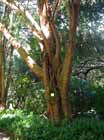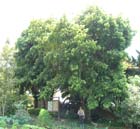
A tree at Kirstenbosch Botanical Garden, South Africa [R. Van Pelt, 2003].

Foliage on a tree at Durban Botanical Garden, South Africa [R. Van Pelt, 2003].

Immature cones on a tree at Kirstenbosch Botanical Garden, South Africa [R. Van Pelt, 2003].

Ornamental tree at Quail Botanical Garden, California [C.J. Earle, 2004.04.06].

Detail of expanding shoot on a tree at the Los Angeles County Arboretum, California. Width of view about 20 cm [C.J. Earle, 1998.03.12].

Conservation Status

Podocarpus henkelii
Stapf ex Dallim. & A.B.Jacks. 1923
Common names
Henkel yellowwood, East Griqualand yellowwood, Natal yellowwood, bastergeelhout; umSonti (X) (Palmer and Pittman 1972).
Taxonomic notes
Syn: P. ensisculus Melville 1954 (de Laubenfels 1985); Podocarpus thunbergii var. falcata Sim. (Palmer and Pittman 1972).
Description
Trees tall, very densely branched. Bark gray to khaki-colored, sometimes peeling in large pieces. Leaves dense, heavy, shiny, dark green, conspicuously drooping, spirally arranged or nearly opposite, sometimes crowded at the ends of branches. Adult leaves usually 9-15 cm × 13 mm, widest at the middle, tapering to both ends. Pollen cones 13-37 mm long, solitary or in small groups. Seed cone olive-green, up to 25 mm long, with a leathery epimatium and a small, blue-green, thickened peduncle (Palmer and Pittman 1972). See García Esteban et al. (2004) for a detailed characterization of the wood anatomy.
This species is sometimes confused with P. latifolius, which has leaves more or less the same thickness in the middle, tapering only towards the apex (Palmer and Pittman 1972).
Distribution and Ecology
South Africa and Tanganika. Based on data from 11 collection localities, it grows at elevations of 1390 ±440 m. Within its range, mean annual temperature is 16.7°C, with an average minimum in the coldest month of 6.3°C, and a mean annual precipitation of 900 mm (Biffin et al. 2011, Table S5). Zone 10 (cold hardiness limit between -1°C and +4.4°C) (Bannister and Neuner 2001).
It grows "mainly on the southern slopes of forested hills in East Griqualand and southern Natal where there is a good rainfall and where mists are frequent. Reports of its occurrence in Swaziland and the Transvaal have been proved inaccurate" (Palmer and Pittman 1972).
Remarkable Specimens
No data as of 2023.02.07.
Ethnobotany
A popular ornamental, particularly in South Africa (Palmer and Pittman 1972).
Observations
I have only found it at arboreta, as shown in the photos, but there are also quite a few observations recorded on iNaturalist (accessed 2023.02.07).
Remarks
"This tree was named after Dr J. S. Henkel, formerly of the Forestry Department, who was the first to realize that this was a distinct species of yellowwood" (Palmer and Pittman 1972).
Citations
Dallimore, W. and A. B. Jackson. 1923. A Handbook of Coniferae, including Ginkgoaceae. London: Edward Arnold; p. 47. Available: Biodiversity Heritage Library, accessed 2023.02.07.
See also
Adie, Hylton, and Michael J. Lawes. 2011. Podocarps in Africa: temperate zone relicts or rainforest survivors? Pp. 81-100 in Turner, Benjamin L. and Cernusak, Lucas A. (eds.), Ecology of the Podocarpaceae in Tropical Forests. Smithsonian Contributions to Botany. https://doi.org/10.5479/si.0081024X.95.viii, accessed 2023.02.07.
Midgley, J. J., W. J. Bond, and C. J. Geldenhuys. 1995. The ecology of southern African conifers. Pp. 64-80 in N. J. Enright and R. S. Hill (eds.), The Ecology of the Southern Conifers. Washington DC: Smithsonian Institution Press.
The species account at Threatened Conifers of the World.





